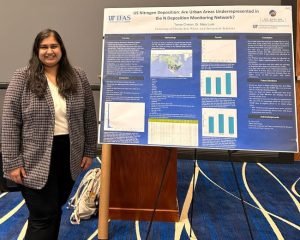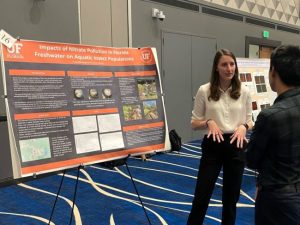Students working with UF/IFAS Department of Soil, Water, and Ecosystem Sciences (SWES) faculty can add undergraduate research to their resume. Tanya Charan and Camille Haupt both focused on a variation of nitrogen (N). Charan examined atmospheric nitrogen deposition in the United States, while Haupt investigated an impact of nitrate pollution. They presented their findings at the UF Center for Undergraduate Research Fall 2023 Symposium.
Nitrogen in the Atmosphere
Charan is a fourth-year soil, water, and ecosystem sciences major with a concentration in water science. Her study, “US Nitrogen Deposition: Are Urban Areas Underrepresented in the N Deposition Monitoring Network?” included hundreds of data points. The National Atmospheric Deposition Program (NADP) includes 250 sites. From each, she collected information such as longitude, latitude, elevation, and levels of ammonium, nitrate, and dissolved inorganic nitrogen.

“Most NADP monitoring sites are in rural areas, which have different concentrations of N compared to urban areas,” Charan explained. “Approximately three out of five of the sites are 20 kilometers from an urban area (population 5,000 or more). That’s not very representative.”
The difference is notable because N sources in urban areas vary from rural settings in both number and concentration. Charan said too much N in the ecosystem leads to soil acidification, algal blooms, and the depletion of important soil nutrients.
“In NADP sites classified as urban and suburban, we found higher levels of nitrate and ammonium, respectively,” Charan said. “It’s important to have more monitoring sites in urban areas.”
She conducted her research under the guidance of Dr. Mary Lusk, a SWES assistant professor of urban water and soil quality.
“Atmospheric deposition, which includes rainfall, is a major source of N to the Tampa Bay estuary and other waterbodies worldwide, where it can be one source of the N that fuels harmful algal blooms,” Lusk explained. “But as I started looking for data on N deposition to urban coastal cities that might face this problem, I realized that most N deposition monitoring sites are far from urban areas.”
She said the first step to changing that was to look at what sites NADP monitors. That’s where Tanya was able to contribute to the project.
“She gathered information about hundreds of NADP sites to show with real data that they do underrepresent urban areas,” Lusk said. “Tanya did a great job with her research and gives us a necessary first piece of information about how we can better monitor the ecology of cities.
“I hope she gets to continue conducting research,” Lusk added. “It was wonderful to be her mentor.”
“Working with Dr. Lusk has been a great experience, especially because she is a wonderful mentor,” Charan said. “I have enjoyed applying what I learned in chemistry and my SWES classes to real-world situations. Knowing this research could make a difference in the science community is really empowering.”
She added that getting to work with large datasets was a new experience she enjoyed, and she is excited to see the future outcomes of the NADP project.
Nitrogen in Freshwater Ecosystems
Camille Haupt’s research is “Impacts of Nitrate Pollution in Florida Freshwater on Aquatic Insect Populations.” She measured levels of nitrate in a variety of rural and urban Gainesville creeks. She also evaluated the presence and relative population sizes of aquatic insects. The goal was to assess the existence of a possible link between nitrate levels and insects.

“Previous studies have shown aquatic insect populations are accurate indicators of the relative water quality of streams and creeks. That’s because of their response to various sources of pollution,” Haupt explained. “While studies have measured insect diversity in northern Florida, mine will specifically compare these populations against concentrations of nitrate.”
The results show negative correlations for nitrate concentrations with taxa richness, an indicator of stream health, and total observed insects. Also, the proportion of insects belonging to the chironomid group was found to be negatively correlated to taxa richness. The findings indicate that lower insect diversity can demonstrate an area may be experiencing anthropogenic pollution.
“These results have the potential to influence local water management policy,” Haupt said. “I hope it inspires efforts to further educate Gainesville residents on the use of fertilizers and their hazards.”
Dr. Masanori Fujimoto, SWES research assistant professor of aquatic microbial ecology, oversaw Haupt’s research.
“There are many opportunities for research on this campus, including Course-Based Undergraduate Research Experience (CURE) classes just like the one I teach,” Fujimoto pointed out. “You can also knock on the door of any faculty member who does research on something you are interested in. They are more than happy to help you navigate your research experiences.”
He said undergraduate research gives students experiences that are different from regular lecture-based coursework.
“You will learn more about specific issues and subjects you work on, and you will learn them more actively as YOU seek out information that you need to conduct your research,” Fujimoto said. “You will also make your own decisions related to your research based on information you collect, which will help develop your critical thinking skills.”
More information about undergraduate research opportunities at the University of Florida is here.
 3
3
